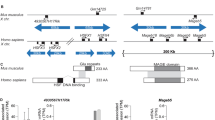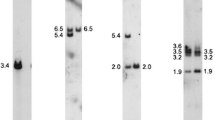Abstract
The SOX genes comprise a large family related by homology to the HMG-box region of the testis-determining gene SRY. We have cloned and sequenced the human SOX4 gene. The open reading frame encodes a 474 amino acid protein, which includes an HMG-box. The non-box sequence is particularly rich in serine residues and has several polyglycine and polyalanine stretches. With somatic cell hybrids, human SOX4 has been mapped to Chromosome (Chr) 6p distal to the MHC region. There is no evidence for clustering of other members of the SOX1,-2, and-3 or SOX4 gene families around the SOX4 locus.
Similar content being viewed by others
References
Alexander, B.M., Dugast, I., Ercolani, L., Kong, X.F., Giere, L., Nasrin, N. (1992a). Multiple insulin-responsive elements regulate transcription of the GAPDH gene. Adv. Enzyme Regul. 32, 149–59.
Alexander, B.M., Ercolani, L., Kong, X.F., Nasrin, N. (1992b). Identification of a core motif that is recognized by three members of the HMG class of transcriptional regulators: IRE-ABP, SRY, and TCF-1 alpha. J. Cell Biochem. 48, 129–135.
Aviv, H., Leder, R. (1972). Purification of biologically active globin mRNA by chromatography on oligo thymidylic acid cellulose. Proc. Natl. Acad. Sci. USA 69, 1408–1412.
Bennett, D.C., Bridges, K., McKay, I.A. (1985). Clonal separation of mature melanocytes from premelanocytes in a diploid strain: spontaneous and induced pigmentation of premelanocytes. J. Cell Sci. 77, 167–183.
Carr, C.S., Sharp, P.A. (1990). A helix-loop-helix protein related to the immunoglobulin E box-binding proteins. Mol. Cell. Biol. 10, 4384–4388.
Chirgwin, J.M., Przybyla, A.E., MacDonald, R.J., Rutter, W.J. (1979). Isolation of biologically active ribonucleic acid from sources enriched in ribonuclease. Biochemistry 18, 5294–5299.
Denny, P., Swift, S., Brand, N., Dabhade, N., Barton, P., Ashworth, A. (1992a). A conserved family of genes related to the testis determining gene, SRY. Nucleic Acids Res. 20, 2887.
Denny, P., Swift, S., Connor, F., Ashworth, A. (1992b). An SRY-related gene expressed during spermatogenesis in the mouse encodes a sequence-specific DNA-binding protein. EMBO J 11, 3705–3712.
Eisinger, M., Marko, O. (1982). Selective proliferation of normal human melanocytes from premelanocytes in a human diploid strain. Proc. Natl. Acad. Sci. USA 79, 2018–2022.
Falb, D., Maniatis, T. (1992). Drosophila transcriptional repressor protein that binds specifically to negative control elements in fat body enhancers. Mol. Cell. Biol. 12, 4093–4103.
Farr, C.J., Goodfellow, P.N. (1992). Hidden messages in genetic maps. Science 258, 49.
Feinberg, A.P., Vogelstein, V. (1984). A technique for radiolabelling DNA restriction endonuclease fragments to high specific activity. Anal. Biochem. 137, 266–267.
Ferrari, S., Harley, V.R., Pontiggia, A., Goodfellow, P.N., Lovell-Badge, R., Bianchi, M.E. (1992). SRY, like HMG1, recognises sharp angles in DNA. EMBO J. 11, 4497–4506.
Giese, K., Cos, J., Grosschedl, R. (1992). The HMG domain of lymphoid enhancer factor 1 bends DNA and facilitates assembly of functional nucleoprotein structures. Cell 69, 185–195.
Griffiths, R. (1991). The isolation of conserved DNA sequences related to the human sex-determining region Y gene from the lesser black-backed gull (Larus fuscus). Proc. R. Soc. Lond. Biol. 244, 123–128.
Gubbay, J., Collignon, J., Koopman, P., Capel, B., Economou, A., Munsterberg, A., Vivian, N., Goodfellow, P., Lovell, B.R. (1990). A gene mapping to the sex-determining region of the mouse Y chromosome is a member of a novel family of embryonically expressed genes. Nature 346, 245–250.
Han, K., Levine, M.S., Manley, J.L. (1989). Synergistic activation and repression of transcription by Drosophila homeobox proteins. Cell 56, 573–583.
Harley, V.R., Jackson, D.I., Hextall, P.J., Hawkins, J.R., Berkovitz, G.D., Sockanathan, S., Lovell, B.R., Goodfellow, P.N. (1992). DNA binding activity of recombinant SRY from normal males and XY females. Science 255, 453–456.
He, X., Gerrero, R., Simmons, D.M., Park, R.E., Lin, C.J., Swanson, L.W., Rosenfeld, M.G. (1991). Tst-1, a member of the POU domain gene family, binds the promoter of the gene encoding the cell surface adhesion molecule Po. Mol. Cell. Biol. 11, 1739–1744.
Jantzen, H.-M., Admon, A., Bell, S.P., Tjian, R. (1990). Nucleolar transcription factor hUBF contains a DNA-binding motif with homology to HMG proteins. Nature 344, 830–836.
Kwon, B.S., Haq, A.K., Pomerantz, S.H., Halaban, R. (1987). Isolation and sequence of a cDNA clone for human tyrosinase that maps at the mouse c-albino locus. Proc. Natl. Acad. Sci. USA 84, 7473–7477.
Larin, Z., Monaco, A.P., Lehrach, H. (1991). Yeast artificial chromosome libraries containing large inserts from mouse and human DNA. Proc. Natl. Acad. Sci. USA 88, 4123–4127.
Lee, C.Q., Yun, Y.D., Hoeffler, J.P., Habener, J.F. (1990). Cyclic-AMP-responsive transcriptional activation of CREB-327 involves interdependent phosphorylated subdomains. EMBO J. 9, 4455–4465.
Licht, J.D., Grossel, M.J., Figge, J., Hansen, U.M. (1990). Drosophila Kruppel protein is a transcriptional repressor. Nature 346, 76–79.
Nagarajan, L., Louie, E., Tsujimoto, Y., Ar-Rushdi, A., Huebner, K., Croce, C.M. (1986). Localization of the human pim oncogene (PIM) to a region of chromosome 6 involved in translocations in acute leukemias. Proc. Natl. Acad. Sci. USA 83, 2556–2560.
Nasrin, N., Buggs, C., Kong, X.F., Carnazza, J., Goebl, M., Alexander, B.M. (1991). DNA-binding properties of the product of the testis-determining gene and a related protein. Nature 354, 317–320.
Nicholas, J.F., Dubois, P., Jakob, H., Gaillard, J., Jacob, F. (1973). Teratocarcinome delasouris: differenciation en culture d'une lignee de cellules primitives a potentialites multiples. Ann. Microbiol. 126, 3–22.
O'Mahony, D.J., Smith, S.D., Xie, W., Rothblum, L.I. (1992). Analysis of the phosphorylation, DNA-binding and dimerization properties of the RNA polymerase I transcription factors UBF1 and UBF2. Nucleic Acids Res. 20, 1301–1308.
Omerod, E.J., Everett, C.A., Hart, I.A. (1986). Enhanced experimental metastatic capacity of a human tumour line following treatment with 5-azacytidine. Cancer Res. 46, 884–890.
Ragoussis, R., Senger, G., Mockridge, I., Sanseau, P., Ruddy, S., Dudley, K., Sheer, D., Trowsdale, J. (1992). A testis-expressed Zn finger gene (ZN76) in human 6p21.3 centromeric to the MHC is closely linked to the human homolog of the t-complex gene tep-11. Genomics 14, 673–679.
Rowley, A., Singer, R.A., Johnston, G.C. (1991). CDC68, a yeast gene that affects regulation of cell proliferation and transcription, encodes a protein with a highly acidic carboxyl terminus. Mol. Cell. Biol. 11, 5718–5726.
Sambrook, J., Fritsch, E.F., Maniatis, T. (1989). Molecular Cloning: A Labotatory Manual, 2nd ed. (Cold Spring Harbor, N.Y.: Cold Spring Harbor Laboratory Press).
Sinclair, A.H., Berta, P., Palmer, M.S., Hawkins, J.R., Griffiths, B.L., Smith, M.J., Foster, J.W., Frischauf, A.M., Lovell, B.R., Goodfellow, P.N. (1990). A gene from the human sex-determining region encodes a protein with homology to a conserved DNA-binding motif. Nature 346, 240–244.
Suzuki, N., Rohdewohld, H., Neuman, T., Gruss, P., Scholer, H.R. (1990). Oct-6: a POU transcription factor expressed in embryonal stem cells and in the developing brain. EMBO J. 9, 3723–3732.
Todd, J.A. (1990). The role of MHC class II genes in Type 1 diabetes. Curr. Top. Microbiol. Immunol. 164, 17–40.
Travis, A., Amsterdam, A., Belanger, C., Grosschedl, R. (1991). LEF-1, a gene encoding a lymphoid-specific protein with an HMG domain, regulates T-cell receptor alpha enhancer function. Genes Dev. 5, 880–894.
van de Wetering, M., Oosterwegel, M., Dooijes, D., Clevers, H. (1991). Identification and cloning of TCF-1, a T lymphocyte-specific transcription factor containing a sequence-specific HMG box. EMBO J. 10, 123–132.
Waterman, M.L., Fischer, W.H., Jones, K.A. (1991). A thymusspecific member of the HMG protein family regulates the human T cell receptor Cα enhancer. Genes Dev. 5, 656–669.
Zuo, P., Stanojevic, D., Colgan, J., Han, K., Levine, M., Manley, J.L. (1991). Activation and repression of transcription by the gap proteins hunchback and Kruppel in cultured Drosophila cells. Genes Dev. 5, 254–264.
Author information
Authors and Affiliations
Rights and permissions
About this article
Cite this article
Farr, C.J., Easty, D.J., Ragoussis, J. et al. Characterization and mapping of the human SOX4 gene. Mammalian Genome 4, 577–584 (1993). https://doi.org/10.1007/BF00361388
Received:
Accepted:
Issue Date:
DOI: https://doi.org/10.1007/BF00361388




